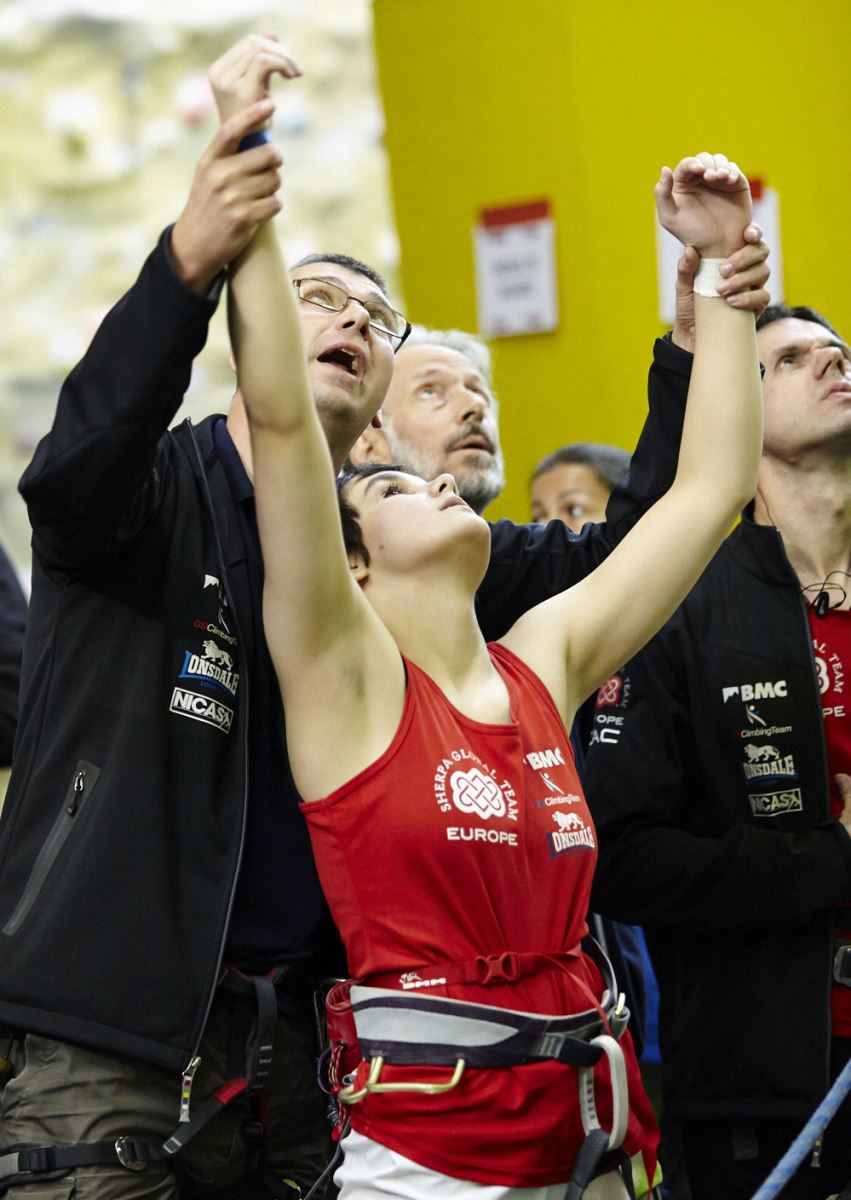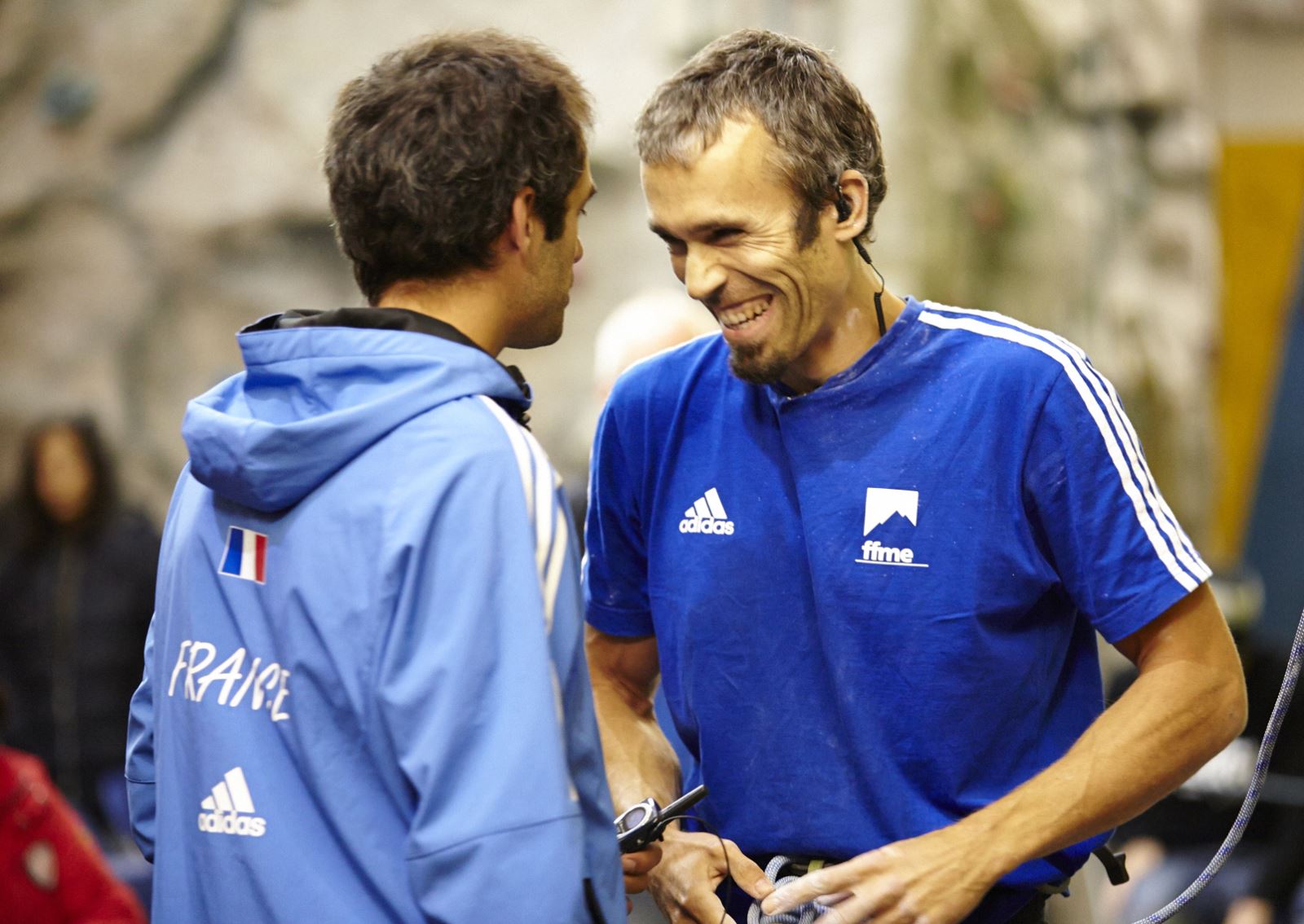Could you help be the eyes for another climber? Roger Fanner tells us about the privilege and responsibility of being a sight guide for visually impaired climbers and ponders the future of the role.
I am not sure that “caller” is the right word but, as no more appropriate description is available yet, it will have to do. This is after all a whole new area of climbing. So what does a caller do?
A visually impaired climber does not climb alone. ‘Yes’ they could reach around for a hold and make steady but strength sapping progress, but in practise it works best if there is someone who can tell them where the holds are. That person is their “caller”, “guide” or “eyes”. This is quite normal for recreational climbing and is allowed, indeed encouraged, in both domestic and international competitions.
Along with a number of others I have had the privilege of acting as John Churcher’s caller more or less since he started climbing with Solihull Mountaineering Club, through to his membership of the GB Paraclimbing team and participation in international competitions. I say ‘privileged’ because I can only admire his skill, strength, and sheer determination to be a great climber. Check out www.johnchurcherparaclimber.com to see what John’s up to.
Have you ever attempted climbing with a blindfold on? Try it – it’s a very interesting experience. Start with assessing the route then putting the blindfold on. Then move onto a climb you have not had a chance to assess and are not familiar with. Have a go at that. It is not easy. It’s also very tiring as you hold on with one hand whilst feeling around with the other.
Most of us learn from watching others. Looking how a good climber overcomes something you have been struggling with is a great way to crack the problem. Often this comes down to throwing some unusual shapes or making a dyno towards a hold you can see. Visually impaired climbers generally can not do that. There are degrees of visual impairment. A B1 climber is more or less completely blind; B2 is less than 5% and B3 is up to 20%.

GB paraclimbing team member Reanne Racktoo has cortical visual impairment and climbs as B3. Photo: Nick Pope
John is a B2 climber and has some limited vision still. He describes it as looking in a mirror and being only able to see an eye or his mouth reflected back. His ability to distinguish colour is also poor. A red hold on a brown background is almost invisible as far as John is concerned. In competitions the route setters have to be acutely aware of the difficulties that VIs have finding the holds.
We went to the international paraclimbing competition at the Westway wall in London on 21 and 22 September. I could only do the Saturday qualifying round. Sam, a fellow club member, took over for the Sunday finals. It was all pretty awe inspiring and I think I was more nervous than John was. The French team were all terribly disciplined. The sight of their synchronised warm up was daunting enough. They were clearly taking things very seriously. The British and Italians were much more laid back and even appeared to be enjoying themselves!
John had two routes to climb. The first was fairly straight forward – probably about 6a. In the qualifiers climbers and their callers get a while to examine a route and there is a demonstration climb to show how the route can be done. We had a chance to go through it and consider how the moves might be done. I started with a general description “it goes up an arête”, “most of the holds are on the lefhand side”, and then moved onto the more specific instructions about each sequence.
So far so good. The VI climbers start the competition and I watch how it goes. Some callers shout out their instructions; other, mercifully including John, have technology to assist them – we were using a microphone for me, with small ear plugs for John, to convey the information that he needed. It is hard enough work calling out the holds to a climber at an indoor wall. Doing it in public at an international competition was not an attractive thought.
Experience has proved that calling a route is about giving the general information first and then precise instructions about where to find the next hold for a hand or foot. We have developed a clock face method that seems to work well enough for John. So the next hand hold might be ‘called’ as “left hand, eleven o’clock, 18 inches, sidepull.” That is usually sufficient for John to get his correct hand and limited focus into the right area for him to find the hold.
Following my guidance (well mostly!) John tops out on this route without difficulty. Now we are onto serious stuff. The demo climb of the second route shows that it’s a much more difficult proposition. Overhanging with complex hold shifts with a tufa layback to start. I talk it through with John. When it comes to his turn he follows our strategy for the tufa with apparent ease and then starts over to the next section. It involves a jug near the top of the tufa, some footholds over on the left and a large hold in the middle which I assume has a reasonable edge on the top. It’s very soon apparent that it is not a good hold at all and John is having difficulties.
The plan was to go from the big hold onto the sidepull further to the right and then up from there, but it’s just not going to work. I can see the strength seeping from John. He is in no position to try anything else and so here we are in an international competition and I cannot think of another way through this. The stuff of nightmares but the end is inevitable. John comes off and is lowered down to the ground. I am gutted.
The Italian climber gets to almost exactly the same position and also comes off although he manages to touch the side pull before doing so. The French machine goes straight through this problem and almost tops out. Never mind John is through to the finals.
The next day the route gets even more difficult. Again the Frenchman gets higher than anyone else. John and Simone, the Italian climber, reach exactly the same hold. There cannot be a tie so Simone’s extra hold touched in the qualifiers gives him the second place with John a very strong third...... but if only I had read that route slightly better he would have got the second place.

Nicolas Moineau's winning performance was outstanding. Photo: Nick Pope
I tell the story because it sets the scene for the thoughts that follow and it gives a feeling for the responsibility that callers take on. There has to be quite a bond between them and their VI climbers. Mutual trust and shared experience are crucial. A VI climber will struggle to climb at competition level without a caller they know and understand.
John has been very good about my failure to read the route correctly but I still feel guilty that I did not get it right for him. He is the one who has been training for months, day in day out.
So what does our experience tell us? Firstly, to succeed at competition level, VI climbers need to have a small group of callers who they work with frequently. One of that group needs to travel with them to competitions, particularly international ones. However there is currently no funding for the climber or guide dog, let alone their caller. If the country is serious about para-sport and para-climbing in particular, somebody needs to find some money from somewhere.
Secondly the caller needs to be able to read the route and therefore needs to be a reasonably good climber in their own right. The French caller was another member of their team, knew what their climber was capable of and got the moves spot on. I confess I cannot read 7a routes let alone do them.
Thirdly, we need to develop a standard system of calling the holds. That is feasible for a small team based around a single climber, but to facilitate training of other climbers, sharing of expertise and ensure resilience, everyone involved needs to be working with the same understanding. As I mentioned earlier we use a clock hand system, with variations as required – eg “there’s a big hold between your legs at knee level” or “it’s in line with the rope”. However, it may be that a moving grid would be more effective and there may well be other systems that could be used.
Could technology help? It would be very easy to take a photo, or even a video, of the route and play it back to John. With his limited vision this might be easier to identify the route as the image could be moved around and enlarged. Most tablet computers could do that very quickly. As yet this is completely untested.
Could Googleglass like technology be used to beam an image of the route in front of the climber’s eyes? It might need a camera set up behind the audience, or even small cameras on a helmet, but why not?.................and what would the rules say?
As I said at the start this is a whole new area of climbing, so standards and norms have not yet been developed. There is no reason why the UK should not be in the forefront of this area. There is work to do.
Written by Roger Fanner
« Back